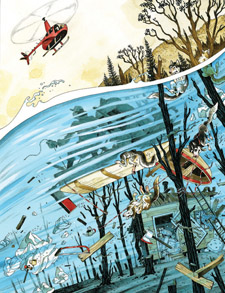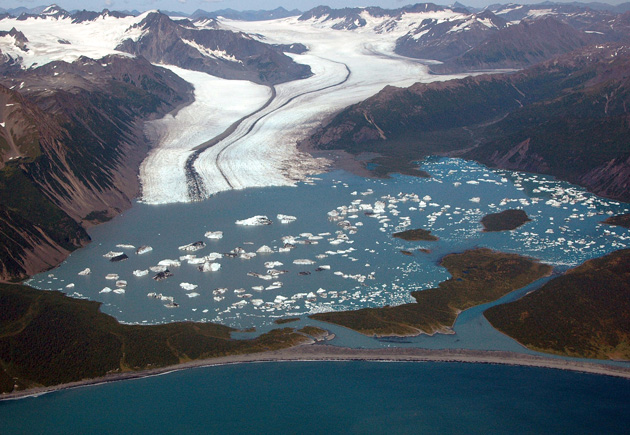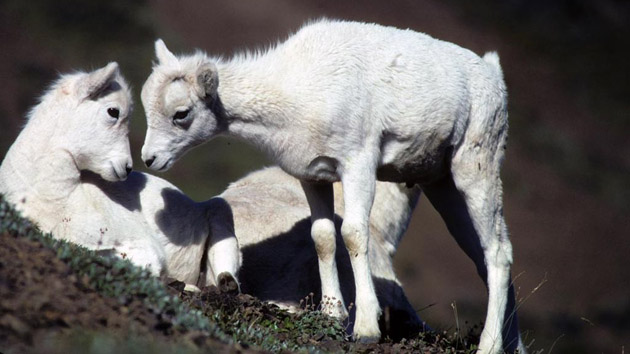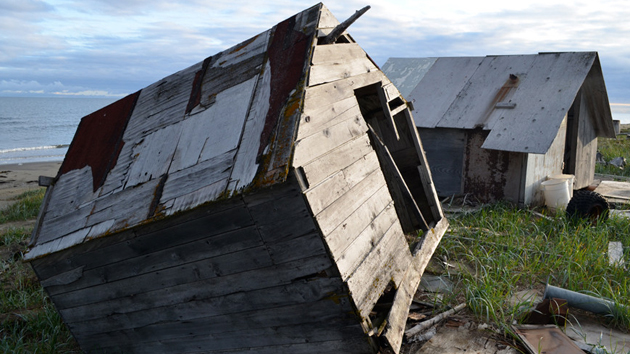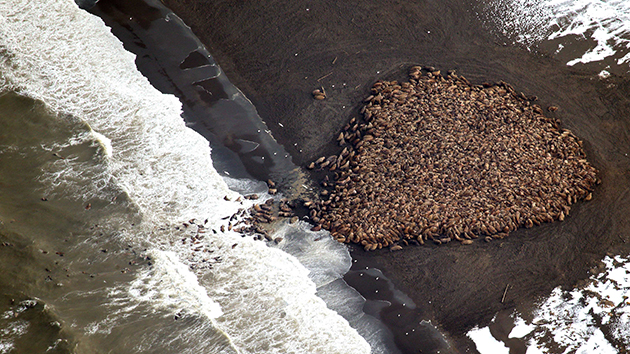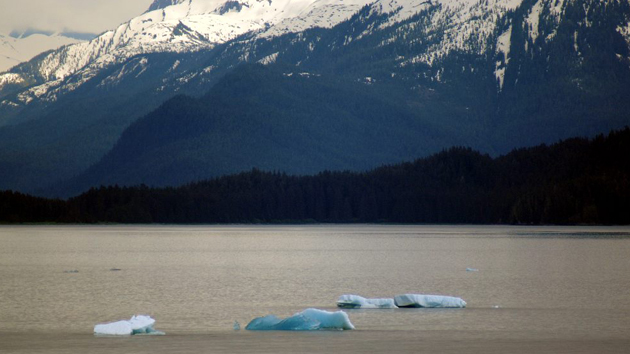
Bear Glacier, Alaska, in 2007. <a href="https://www.flickr.com/photos/bestrated1/173183769/in/photolist-giBv4-ecJeBX-ymcqC-5VEKre-6uUkWz-6uUiiK-6Urgrp-eUXjBW-6EA4rF-4UMJ2B-bjmrbK-6SjJoG-8ERACd-BXTb5-eUXA9o-eUL6op-avDTa7-4URWWA-fuYk4P-oZiQS6-7KaTfd-6FwqGX-65Ttgw-5PGWkJ-6reB9P-81UrGv-jE5y2a-bFh9LD-7uQRgt-p5LMi9-4RdQJk-7CckL5-iq7A3G-hkb59n-hkaU7t-6uUi1T-asumXh-fY17np-hk9Smh-dZ5L1k-a8EQhJ-gBMJMP-9mnejh-4qBnbD-5PLuhd-7GGukv-aJVvva-4RibSQ-DBMJU-7Nij5L">Tim Hamilton</a>/Flickr
This article originally appeared in Slate and is republished here as part of the Climate Desk collaboration.
Earlier this winter, Monica Zappa packed up her crew of Alaskan sled dogs and headed south, in search of snow. “We haven’t been able to train where we live for two months,” she told me.
Alaska’s Kenai Peninsula, which Zappa calls home, has been practically tropical this winter. Rick Thoman, a meteorologist with the National Weather Service in Alaska, has been dumbfounded. “Homer, Alaska, keeps setting record after record, and I keep looking at the data like, Has the temperature sensor gone out or something?“
Something does seem to be going on in Alaska. Last fall, a skipjack tuna, which is more likely to be found in the Galápagos than near a glacier, was caught about 150 miles southeast of Anchorage, not far from the Kenai. This past weekend, race organizers had to truck in snow to the ceremonial Iditarod start line in Anchorage. Sen. Lisa Murkowski of Alaska tweeted a photo of one of the piles of snow with the hashtag #wemakeitwork.
But it’s unclear how long that will be possible. Alaska is heating up at twice the rate of the rest of the country—a canary in our climate coal mine. A new report shows that warming in Alaska, along with the rest of the Arctic, is accelerating as the loss of snow and ice cover begins to set off a feedback loop of further warming. Warming in wintertime has been the most dramatic—more than 6 degrees in the past 50 years. And this is just a fraction of the warming that’s expected to come over just the next few decades.
Of course, it’s not just Alaska. Last month was the most extreme February on record in the Lower 48, and it marked the first time that two large sections of territory (more than 30 percent of the country each) experienced both exceptional cold and exceptional warmth in the same month, according to data from the National Oceanic and Atmospheric Administration. All-time records were set for the coldest month in dozens of Eastern cities, with Boston racking up more snow than the peaks of California’s Sierra Nevada. A single January snowstorm in Boston produced more snow than Anchorage has seen all winter. The discrepancy set off some friendly banter recently between the Anchorage, Boston, and San Francisco offices of the National Weather Service.
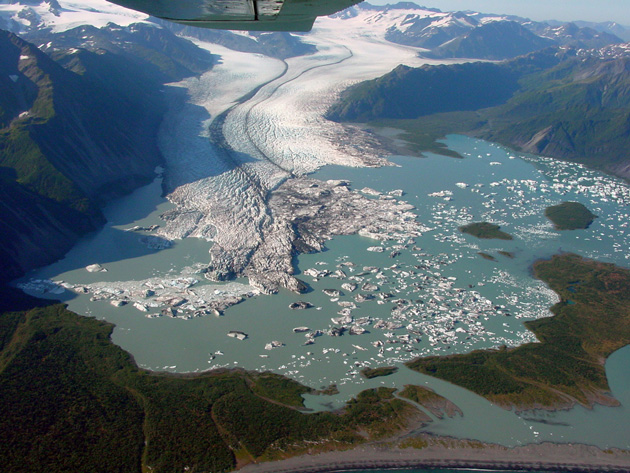
Alaska is at the front lines of climate change. This year’s Iditarod has been rerouted—twice—due to the warm weather. The race traditionally starts in Anchorage, which has had near-record low snowfall so far this winter. The city was without a single significant snowstorm between October and late January, so race organizers decided to move the start from the Anchorage area 360 miles north to Fairbanks. But when the Chena River, which was supposed to be part of the new route’s first few miles, failed to sufficiently freeze, the starting point had to move again, to another location in Fairbanks.
On Monday, Zappa and her dogs set out on the 1,000-mile race across Alaska as one of 78 mushers in this year’s Iditarod. A burst of cold and snow are in the forecast this week, but for most of the winter, the weather across the interior of the state has also been abnormally warm. To train, many teams of dogs and their owners had to travel, often “outside”—away from Alaska. Zappa ended up going to the mountains of Wyoming.
For Iditarod entrants, the warm weather can mean life or death. Last month, along the Iditarod route, a snowmobiler had to be rescued after unknowingly trying to cross open water. A recent study said that Alaska’s rivers and melting glaciers are now outputting more water than the Mississippi River. Last year was Alaska’s warmest on record and the warm weather has continued right on into 2015. This winter, Anchorage has essentially transformed into a less sunny version of Seattle. As of March 9, the city has received less than one-third of its normal amount of snow. In its place? Rain. Lots of rain. In fact, schools in the Anchorage area are now more likely to cancel school due to rain and street flooding than cold and snow.
Of course, it wasn’t always this way. Alaska’s recent surge of back-to-back warm winters comes after a record-snowy 2012, in which the National Guard was employed to help dig out buried towns. Then, about two years ago, something in the climate system switched. The state’s recent brush with extreme weather is more than just year-to-year weather variability. Alaska is at the point where the long-term trend of warming has begun to trump seasonal weather fluctuations. A recent shift toward warmer offshore ocean temperatures is essentially adding more fuel to the fire, moving the state toward more profound tipping points like the irreversible loss of permafrost and increasingly violent weather. If the current warm ocean phase (which began in 2014) holds for a decade or so, as is typical, Alaska will quickly become a different place.
The Pacific Ocean near Alaska has been record-warm for months now. This year is off to a record-wet start in Juneau. Kodiak has recorded its warmest winter on record. A sudden burst of ocean warmth has affected statewide weather before, but this time feels different, residents say. In late February, National Weather Service employees spotted thundersnow in Nome—a city just 100 miles south of the Arctic Circle. “As far as I know, that’s unprecedented,” Thoman told me. Thunderstorms of any kind require a level of atmospheric energy that’s rarely present in cold climates. To get that outside of the summer is incredibly rare everywhere, let alone in Alaska.
Climate scientists are starting to link the combination of melting sea ice and warm ocean temperatures to shifts in the jet stream. For the past few winters, those shifts have brought surges of tropical moisture toward southern Alaska via potent atmospheric rivers. This weather pattern has endured so long it’s even earned its own name: the Ridiculously Resilient Ridge. The persistent area of high pressure stretching from Alaska to California has shunted wintertime warmth and moisture northward into the Arctic while the eastern half of the continent is plunged into the deep freeze, polar-vortex style.
The warm water is making its way north into the Arctic Ocean, too, where as of early March, sea ice levels are at their record lowest for the date. The resurgent heating of the Pacific (we’re officially in an El Niño year now) is also expected to give a boost to global warming over the next few years by releasing years of pent-up oceanic energy into the atmosphere, pushing even more warm water toward the north, melting Alaska from all sides.
That means Alaska’s weather, according to one Alaska meteorologist, is “broken.” Dave Snider, who reports statewide weather daily for the National Weather Service’s Alaska office in Anchorage, tweeted the sentiment back in mid-January. Snider emphasizes that this isn’t the official view of the National Weather Service, “of course.” Snider told me he made the comment “sort of in jest” but points to the nearly snow-free Iditarod start as evidence.
Here’s another example he could have used: In early November, Super Typhoon Nuri morphed into a huge post-tropical cyclone, passing through the Aleutians very near Shemya Island on its way to becoming Alaska’s strongest storm on record. Despite winds near 100 mph, Shemya emerged relatively unscathed. A few days later, the remnants of that storm actually altered the jet stream over much of the continent, ushering in a highly amplified “omega block” pattern that dramatically boosted temperatures across the state and sent wave after wave of Arctic cold toward the East Coast. Barrow was briefly warmer than Dallas or Atlanta.
The warm weather isn’t all bad news. The city of Anchorage has saved an estimated $1 million on snow removal this year and is instead pouring the money into fixing potholes and other backlogged maintenance issues. But getting around the rest of the state hasn’t been so easy.
There are few roads in rural Alaska, so winter travel is often done by snowmobiles over frozen rivers. Not this year. Warm temperatures in February led to thin ice and open water in the southwest part of the state near Galena and Bethel. David Hulen, managing editor for the Alaska Dispatch News in Anchorage, has spent nearly 30 years in the state. He says the freeze-thaw cycle is out of whack, “changing the nature of the place.” Usually, things freeze in the fall and unfreeze in the spring; this winter, they’ve seen a nearly constant back-and-forth between freezing and thawing.
That’s made it difficult for skiers and those enjoying other outdoor activities, like riding fat tire bikes attuned to the snow. Julie Saddoris, of the Bike Me Anchorage Meetup, says attendance in her group is down this winter. Because of the lack of snow and ubiquitous slick ice, “riding conditions [are] very poor and hazardous,” she wrote in an email. Hulen agrees that it’s been frustrating. “I mean, what’s living in Alaska if it’s not cold and snowy?”
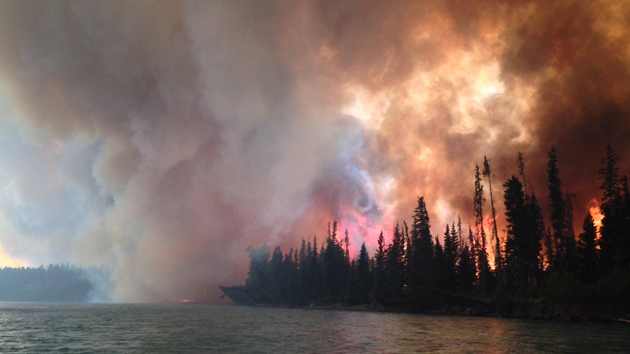
Those are city problems. Meanwhile, along the state’s west coast, some native coastal villages are facing an existential threat, as sea levels rise in response to the warm water. Earlier this winter, the Washington Post‘s climate reporter Chris Mooney visited Kivalina, one of the six villages considering plans to relocate due to climate change. “Here, climate change is less a future threat and more a daily force, felt in drastic changes to weather, loss of traditional means of sustenance like whale hunting, and the literal vanishing of land,” Mooney wrote. Another village, Newtok, is a bit further along in the relocation process, with construction on their new village—Mertarvik—already under way.
The rapid change has brought US Arctic policy to a crossroads. The United States is set to take over a rotating two-year chairmanship of the Arctic Council next month—a mini–United Nations of the north—and has listed climate change as a top agenda item. At the same time, it’s also laying the ground rules for increased oil and gas exploration. In a warmer 21st century, Alaska may be more important than ever—which explains the increased pressure for a boosted military presence there.
But for now, the most visible change is still in the shifting habitats of the fish, birds, trees, and animals. Permafrost still covers 85 percent of the state, but “almost everywhere, the depth of the active layer is increasing over the last few decades,” said Thoman. Since the active layer—the zone of soil above the permafrost that thaws out each summer—now penetrates deeper down, that means landforms are shifting, lakes are draining, and new forests are springing up.
Patricia Owen is a biologist at Denali National Park and Preserve who studies grizzly bears. Last winter, warm weather brought blueberry blossoms earlier than normal. The blossoms then froze, making foraging for food more challenging for bears. Mother bears need to have good health in the fall to support their cubs during the long winter months of hibernation. Owen is seeing evidence of other changes within Denali: More episodes of freezing rain are having a big impact on sheep, which have to scrape through ice to eat. In low snow years like this one, wolves seem to suffer, since caribou and moose can escape more quickly. Studying these changes is difficult because the scientists don’t want to disturb the animals more than necessary. “It takes awhile to really see the effect of some of these things,” Owen told me.
Recent warming appears to have pushed Denali’s poplar forests across a threshold toward rapid expansion. Carl Roland, a Denali plant ecologist who has compiled a trove of repeat photographs around the park spanning decades of environmental change, says that what he’s seeing is “dramatic.” Still, says Roland, “it’s kind of a complicated story, because you have patches of the landscape that have remained pretty much exactly the same, and then you’ve got other patches that have gone off in this other direction.”
Once the permafrost goes, Roland says to expect a “regime shift” in the park and across the state. The northward spread of tree-killing insects is also a “really big unknown” in interior Alaska. Last spring, a huge forest fire in a beetle kill area of the Kenai Peninsula sent smoke plumes hundreds of miles northward toward Fairbanks.
For southern Alaska, fire season has been coming earlier in recent years, and 2015 looks to be no exception. Melvin Slater, a representative for the Alaska Fire Service, told me that the agency is making changes in response to the warm, nearly snow-free winter. “AFS will accelerate the availability of eight smokejumpers and a smokejumper aircraft by April 9 with an additional eight smokejumpers available by April 16,” Slater wrote in an email. That’s about 30 days earlier than normal. A few years ago, the Alaska Division of Forestry statutorily moved the start of the fire season up from May 1 to April 1 “as a result of climate change,” Tim Mowry, a division spokesman told me. The changes were intended to elicit “a sense of urgency,” Mowry says.
But there’s a kink in these plans. Alaska government is strongly dependent on oil revenue—and falling fuel prices are forcing budget cuts to state agencies like the Division of Forestry.
But for now, the Iditarod will continue. “Honestly, I’m thinking of moving, whether it be further north in Alaska or somewhere where they can guarantee snow,” Zappa said. “If you’re going to be a dog musher, you need snow. That’s the bottom line.”
